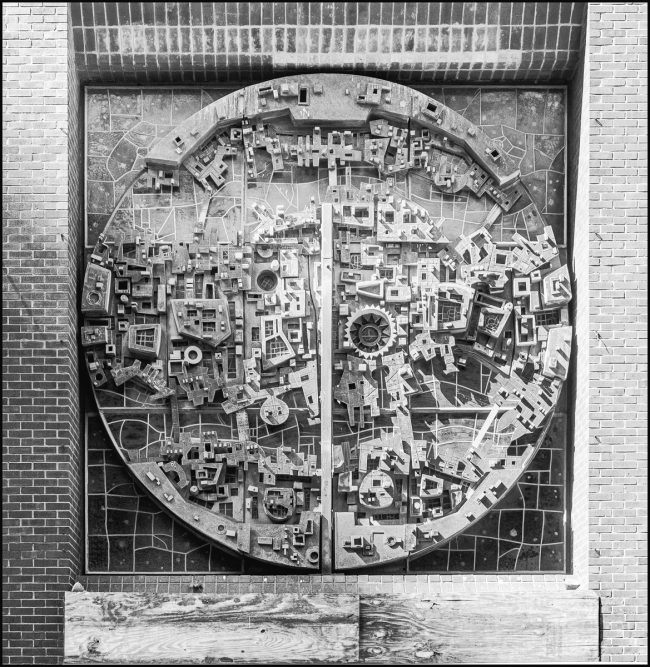I came across this rather intricate sculpture and stained glass window on the brown brick façade of what was once the Capuchin Monastery of St. John the Baptist. It was built in 1974 in the Brutalist style and was one of the buildings associated with the St. John The Baptist church on West 31st. NYC. It was sold to a retail property developer in 2016.
Pictures of the monastery before it was sold show a standing Christ figure in front of the medallion. I believe the sculpture was called “Christ over the City” and the artist was Benoit Gilsoul.
Benoît D. Gilsoul, 1914- 2000 was Born in Namur, Belgium anld completed his primary studies and Greek-Latin humanities. He then entered the Académie Royale des Beaux Arts, the most prestigious Belgian art college from which he graduated in 1938. During the six years at the Académie, Gilsoul acquired a solid artistic training. By 1933, he had already founded the secessionist art group: “L’Esquisse,” an influential group of young artists in Belgium that developed into the group “Salon National des Jeunes Artistes”. In 1935, while still at the Académie, he collaborated in the design for the entrée Reine Astrid and the pavillon de la vie Catholique at the World’s Fair in Brussels, Belgium. During that same year, he also undertook an extensive study tour with Nicolas de Stael, a close friend and fellow student. Upon graduation from the Académie, Gilsoul traveled extensively in Italy, France and Spain painting and drawing continuously.
In 1958, he became président of the Association des Artistes Belges where he remained honorary president until his death in 2000. In 1960, he was commissioned to execute the murals in the Salle de Réception for the Belgian Line in Antwerp. Also in 1960, the Belgian government sent him to the United States on a grant to study the artists’ situation in that country. Gilsoul quickly fell in love with America and upon his return to Belgium decided to resettle in America with his family and became an American citizen in 1967. In 1960, he began to design and work extensively in the field of stained glass while continuing his work in painting, print making, tapestry, and sculpture. He operated his own studio in New York where he created, designed and executed his work. Gilsoul is regarded today as one of the foremost artists in the field of Stained Glass.
Thomas Venturella had the honor and pleasure of working with this renowned artist from 1969 through the 1980’s. He fabricated many of Gilsoul’s windows including those for St. John’s Capuchin Monastery in New York City, “Christ Over the City”. Venturella states that “Benoît Gilsoul was a major force in the field of stained glass and one of the best colorists this medium has known.” (Adapted from Venturella Studio)
According to a post on Flickr:
Above the entrance to the Capuchin Monastery Church of St. John is the largest outdoor religious statue in New York City. The eleven foot Romanesque figure, entitled “Christ in the City” is polished bronze.
The background is a stained glass-stone-and-metal window representing Manhattan island with the East River and Brooklyn above, and the Hudson River and New Jersey below. Buildings, bridges, parks, docks and ships can be seen in the stone work of the window. The dominant colors of the stained glass are red, symbolizing charity, and blue, symbolizing spirituality.
The sculptor, Benoit Gilsoul states, “The call to spirituality is the meaning of the window. This is why St. John’s Church is here, why the Capuchin Franciscans are here. The city is spiritually dark, but a deep shadow is cast only by a bright light. Christ is the light of the city. The window is a call to the spirituality.”
The statue was dedicated by Terence Cardinal Cooke Archbishop of New York, on April 19, 1975.
It’s certainly interesting, but as mentioned above, the figure is no longer there. I wonder what happened to it?
Taken with a Fuji X-E3 and Fuji XC 16-50mm f3.5-5.6 OSS II

